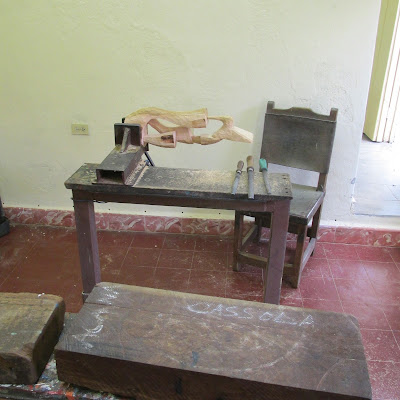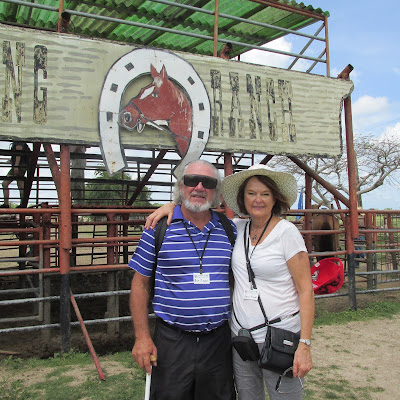Cuba--it's complicated.
Our first sight of Cuba from the air was low bits of land with roads and more water than land. Then came mostly brown featureless land with little to see. I wondered where Columbus saw “the most beautiful earth human eyes have seen.” Not here. As we flew on, however, more green appeared with lakes and trees. Camaguey looked densely packed with buildings, few green spaces or trees. We knew we had stepped back in time when a stairway was rolled across the tarmac for us to disembark. The terminal was one big room for security, health forms, baggage claim, and customs.
Soon we were in a modern Chinese bus rolling into the city, colorful lines of houses along the road, all built against each other. Many have tanks on the flat roof to store water for the rationing days when water is turned off one day or more a week. Bars or fancy iron grates covered the windows and were open at the doorways during the day. This is to allow people to sleep with windows all open for the breezes to cool the house.
Lunch was in a lovely old palador, a restaurant in a private home. The building was a large colonial mansion with a central courtyard and a magnificent bar with more kinds of liquor than one usually sees. The food was just delicious and the beer welcome in the heat.
The Santa Maria church honors the original saint and name of the city which was founded 80 kilometers away on the coast. Pirates and unfriendly natives drove them inland to the current location where the name was changed to Camaguey. The church had wonderful dark wood lining many alcoves holding statues of saints. The altar has three impressive statues representing the trinity—Father, Son and Holy Spirit.
We did a short walking tour to see several artists’ studios and shops. Beautiful wood carvings were hand made in a simple wood shop.
The wood carver
Another had amazing leather pieces including striking busts with two faces to represent the two sides within each person.
A highlight of the day was bici-taxis—bicycle taxis. They are everywhere. Some have platforms on the back instead of a passenger seat for hauling cargo. We rode around for many blocks viewing homes with the doors open showing living spaces and a glimpse of a small courtyard out back. Children waved; old men played checkers; young women washed floors or walls; old women sat on the stoop. Bicycles zipped everywhere. Small wagons drawn by a single horse or donkey can carry six passengers or cargo. Most of the roads are too narrow for cars to meet each other. We had to walk the last few blocks to our hotel because the bus could not get closer.
The sculpture and the model
The Gran Hotel had a grand old lobby and courtyard bar where they served complimentary Cuba Libre—rum and coke with lime wedges. Our room was small with two twin beds covered in a strange mix of 50’s and modern decor. No hair dryer or shampoo, but the tiny TV did bring in some American sports and news for Don.
Dinner was at another palador. Food was OK, but the courtyard entertainment was phenomenal. Flamenco dancers enchanted us with the swirl of skirts and sultry interchanges among the one young man and three gorgeous young women. Did I say the guy was hot? And I mean other than working himself into a sweat. Their dancing was sexy, joyous, and precise. A few numbers featured tapping their shoes in intricate rhythms. We were enthralled.
As we traveled out to the King Ranch, Manuel instructed us on Cuban history and current life on this lovely island. Cubans believe that they have many advantages thanks to communism—free high quality healthcare and education, jobs and infrastructure. Farmers receive seeds, machinery, and cattle feed. Cubans don’t fear zika or dengue because they have been serious about controlling mosquitoes for many years. Cuba has better healthcare and a lower infant mortality rate than the U.S. Their doctors and engineers are considered superior around the world. Teachers are respected as the base for all of this. Many people work for the government and pay no taxes. Private businesses such as restaurants, AirB&B rooms, farming, and sales of produce and other products do pay the government a monthly stipend and tax on profits. These private enterprises provide people much higher income than government jobs, and they are approved.
Internet is only what the government approves, and availability is sparse. Here people gather in the evening at a city square with WiFi, everyone focused on their own devices.
It is a very safe country, no violent crime. No one has guns except the military. Drugs are not a problem; Cubans have never had enough money to attract the drug cartels. The most common crime is robbery; murder is very rare. Prisoners attend classes for job training and rehabilitation.
Raul Castro expressed the feeling of most Cubans when he conceded that Cuba has made mistakes, but the country must always try to improve. People believe that about personal life too. Problems are there to be solved. The Cuban spirit includes a rebel nature. They have had many struggles for independence, and they do not give up. “Our wine may be sour, but it is our wine.”
The Cuban people are happy. They would like a bit more money and goods, but they do not want their country to change. They value their identity, their “face,” their beautiful land. They treasure the simple life. Cubans are very friendly and enjoy other people, but they fear that heavier tourism may spoil the best aspects of their country. They really do not want the materialism of other places. Love, peace and harmony are more important.
Slavery was brought to Cuba by the European colonialists to work the sugar plantations first, then coffee and tobacco. Slaves came from Africa, South America and China. Slavery was abolished in 1886. Some restrictions remained for a while, but not pervasive. Baptista was mulatto. Since the revolution in 1959, racism is not a problem. There are so many racial differences that everyone is content with the variety.
The King Ranch was founded as a foreign subsidiary of the Texas King Ranch and once ran 65.000 head of cattle on 20,000 acres. Drought and invasive marabou brush have reduced it to a small, government owned operation.
We were greeted with sangria and a local band.
A rodeo showcased the cowboys’ expertise.
Village boys came to watch the rodeo.
About 200 people live in a village on the property and work the ranch with its livestock, chickens, bananas, gardens and other endeavors. People cut lumber for the huts during the waning moon when the sap is down and the lumber is less attractive to termites. Huts are thatched with Cana palm fronds. Most people have refrigerators and TV’s.
This woman was delighted to show us her home.
A school on the property has two teachers for grades K-4. Then children attend a boarding school in a neighboring larger town.
During lunch the band entertained us with alternately wistful and lively Cuban music. Delightful.
On returning to Camaguey, we visited the Casanova family pottery studio for a demonstration by the talented father and son potters who are true artists with clay. They also make enormous pots called tinajones that are common around Camaguey for storing water and food products.
Driving through the countryside is relaxing. Marabou post fences, some sprouting branches, line the roads and separate fields. Trees abound— large glossy, umbrella-shaped trees; palm trees, flowering trees and bushes, mango trees hanging full of fruit, banana palms and many others. Cattle, goats and horses graze in fields and among the trees and sometimes tied outside the fences. Dogs and chickens roam everywhere.
At times the land opened up to fewer natural areas with trees and more large fields containing cattle or sugar cane.
Trinidad is one of the finest colonial towns in the Americas, well preserved by obscurity after the sugar boom that built it, began to fade. On the edge of town we visited a sugar estate with its impressive house and high tower used to observe the sugar cane fields. Crafts and embroidered goods lined the lane to the site with persistent artisans showing their wares.
Lunch was a sumptuous lobster tail with the now familiar salad of fresh cabbage, cucumbers, tomatoes and green beans that we dress at the table with oil and vinegar. We always get beer served as part of the meal, and it tastes great in this heat. The dining decks here wrapped around an enormous Saba tree that gives the restaurant its name.
The old city center features the site of the founding of the town and the first Catholic Church, now an active church of a unique blend of Catholicism and African religiosity. The other buildings around the square were mansions of the sugar barons. Most are now museums of architecture and history or shops.
We drove toward Cienfuegos near the southern coast where families and young people enjoyed numerous beaches in coves and open coastlines.
Cienfuegos is a charming city founded by Frenchman Don Louis de Clouet and 40 families, so the French influence shaped the development of the town. It is located on the southern coast on a large bay with a resort atmosphere. Don and I swam, bouncing in the waves, at the beach at the end of the peninsula near our hotel.
Our tour of the old city, a UNESCO World Heritage site, began with a statue of Beny More who was an early innovative singer who influenced Cuban music as it is now.
The founders’ park is surrounded by the obligatory old Catholic Church and ornate government buildings and mansions of sugar barons, now restored as museums. The beautifully landscaped park was dominated by a statue of Jose Marti, the father of Cuba’s struggle for independence. One of his poem became the Cuban patriotic song “Guantanamera.”
We visited a museum with a small performance room to hear the acapella Cienfuegos Choir. When they sang the first note, my mouth dropped open and my eyes opened wide! The pure voices blended and filled the room, lifting our hearts and spirits. They sang Cuban classical and traditional music and a few American songs. What a joy and privilege to hear them. The choir has been singing for over 50 years, winning international competitions and delighting Cubans throughout the country.























































